This post may contain affiliate links.
It sounds a little crazy, but we really did buy an RV for $1 with the intention of setting it on fire.
A few years ago, we visited an RV salvage yard where hundreds of RVs were damaged by fire. Then last year, six people we knew lost their homes to fire – two of those were homes on wheels – RVs! So we decided to make an RV Fire safety video to help educate more people and keep you and others safe.
But… in this distracted world, how do we ensure enough people will see it and get the information?
Maybe if we actually caught an RV on fire it would get the attention it deserves. Of course, this isn’t something you can go and do in your backyard safely. So, we dove into this multi-month project alongside Fire professionals from the area we were RVing in and the state-level officials too.
This was a big project, and we learned a lot. So this post tells the story and shares a TON of great information with you.
We included some quick links to jump to sections of the post below.
And you can watch the video here – we think it’s the best one we’ve ever done. Let us know what you think in the comments!
Quick Links To Sections Of This Post
- Our crazy RV Fire idea
- Engaging the right fire professionals
- Finding a suitable RV to burn
- Locating an appropriate RV burn site
- How to get the RV to the site
- Prepping the RV for the Fire
- Trouble…. RV Fire cancelled?
- The RV Burn – Setting Harvey on Fire!
- RV Fire Safety Tips
- What are the most common causes of RV fires?
- Fire hazards found in RVs and traditional homes
- How to Prevent RV Fires and stay safe
- RV Fire Safety Tools

Marc stands by a motorhome that was the victim of an RV engine fire
The Crazy RV Fire Safety Idea
So, as mentioned briefly above, we had this crazy idea that the best way to help others avoid loss and injury to fire with their RVs is by actually catching an RV on Fire on purpose. We just knew that the first-hand experience and visuals would be the best way to help educate others.
But you must admit, it sounds a little crazy and dangerous. This isn’t exactly something you can safely do by yourself in your backyard. There are many moving parts and logistics to safely find, transport, burn, and clean up after a big project like this. Could we even pull it off?
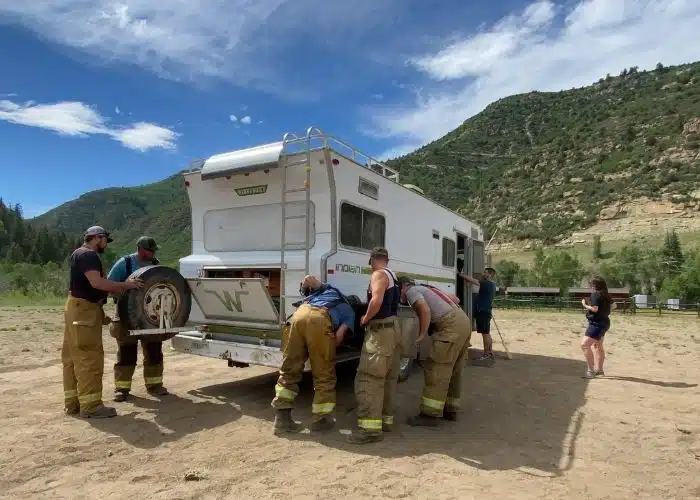
Fire crew inspects Harvey the RV for hazards before the burn
Engaging the RV Fire Fighting Professionals
We were in western Colorado for a few months, so we started asking around in that area. Because before we can even begin considering setting an RV on fire on purpose, we need to make sure we could have the right people on hand to put the fire out.
Before long, we had a conversation with a local fire department chief who really liked the idea. Being a fellow RVer, he loved the idea of bringing extra attention to the additional fire hazards of RVs. Even better, he also believed that he could help us gain the support of state-level officials.
So he connected us with the Colorado Division of Fire Prevention and Control. We met via Zoom with Chuck Altvater, an RVer himself, who was also excited about RV fire safety. By combining resources, we could reach a larger audience and help more people. Chuck was also able to help work with other fire departments across the state so that when we could find a suitable RV and location, the odds were good that the local fire department in that area would come on board too. It is a great training exercise for the fire departments.

Harvey the RV is a 1973 Winnebago Indian motorhome that has seen better days

Grandpa and Grandma had fun with the RV, until it was left to rot in a field for 20 years
Finding a Suitable RV To Burn
In our travels, we always see unused RVs, so we were confident we could find one. The more tricky part would be finding an RV that people watching the fire could relate to. It needed to be nice enough that people could imagine it being a normally functioning and regularly used RV.
But at the same time, we didn’t want to destroy an RV that could be restored and continue to provide great memories of RV travel for new owners. Plus, we had to find one relatively close to the burn site (once that is established) so that we could safely transport it to the scene of the RV fire.
The local fire department reached out to their network, and Julie also reached out to community Facebook networks to find the goldilocks (just right) RV for our RV fire project. Before we knew it, we had multiple RVs to choose from.
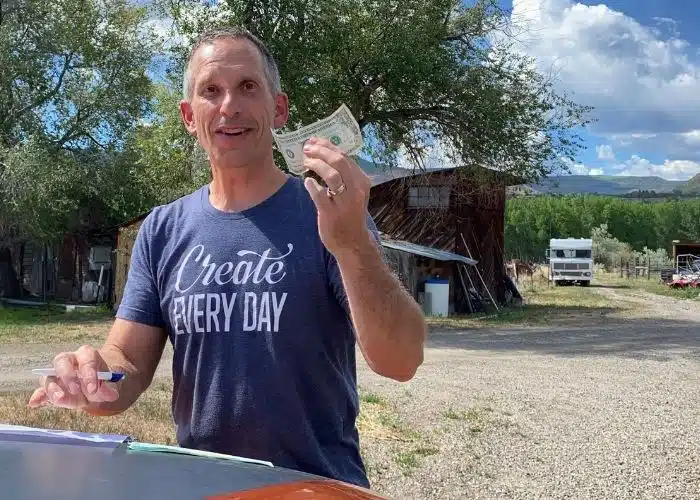
Marc buys Harvey the RV for the princely sum of one dollar!
Which RV Did We Decide On?
The best fit for our RV fire was this 1973 Winnebago Indian 22 motorhome. The owners had some wonderful travels and memories with it for years after they bought it. But after a mechanical issue sidelined the RV, it eventually sat in a field behind their barn for twenty years.
During those 20 years, the roof was damaged by kids jumping on it, which lead to extensive water damage. The metal and chassis were all rusted, and many other parts degraded from lack of use to a point of no return.
The previous owners loved the idea of their memory machine RV making one final journey and helping others stay safe in their RV travels. So they accepted our offer to buy it from them for $1. Yep… ONE dollar for this once iconic RV that once was on many people’s wish lists! Money had to change hands so we could obtain and legally own the title before we set fire to it!
We really loved the look of this old RV. So much personality. We even chose to name our new purchase. Harvey the RV. It is a shame it was no longer restorable, but it was great that it will be able to go to a good cause instead of just continuing to rot in a field.
We hope Harvey’s sacrifice will do a lot for RV fire safety and save thousands of other RVs and the lives of their owners.
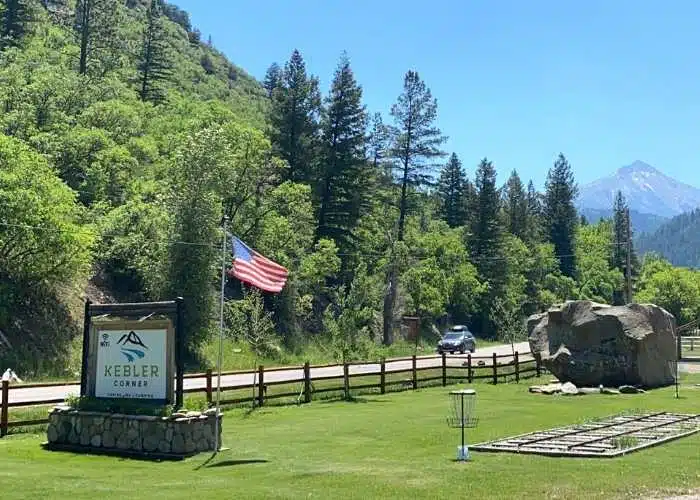
The entrance of scenic Kebler Corner campground in Somerset, Colorado

Our campsite at Kebler Corner
Finding The RV Fire Location
Finding an appropriate place to have such a big fire is difficult. Our first hope was to do the fire in or near a salvage yard so that the RV chassis would not need to be moved again once we were done. But, despite a lot of effort and a good cause, we could not find anyone to accommodate us.
Reaching out to the broader community, we received a message from a very unexpected source. The owners and operators of a beautiful campground in the mountains nearby are big advocates for fire safety in general and RV fire safety in particular. They thought they might have just the right location. So we looked up their campground on our RVLife app and visited.
When we pulled up, we saw the great welcome center and tree-covered RV sites surrounded by forest land covered in trees along a river. But, around the back part of the campground was a huge open space. Apparently, the open space used to be a large horse arena. This large space would give us plenty of space to bring in extra fire trucks and keep enough distance from the beautiful natural surroundings to avoid starting a forest fire.

Aerial view of Kebler Corner Campground

This field was once a horse arena, when the property was owned by a billionaire
More About Our RV Burning Location
With their passion for educating on fire safety, owners Paul and Emily St. Ruth of Kebler Corner offered us to use the space as long as once we were done; we left no trace of the RV fire. Now, we knew it would make a BIG mess, but we were also confident that with the right equipment and help, we could make it look like nothing happened there.
Plus, the location even had cabins in addition to RV sites, so there would be a place to stay for the others coming into the area to help with the project. You can read more in our review of this campground here.
So, we all agreed that it would be the perfect spot and set a date for when we would do the RV fire. We needed to act fast before the wildfire season started, which would put demands on the fire fighting resources and potentially encounter a fire ban that occurs most summers in Colorado mountain areas. Then started making arrangements for all the others to fly or drive into the area to help out. Many hands were needed.

Harvey the RV’s final road trip – being towed to the burn site
Getting the RV to the Fire Site
Though we could buy the RV for one dollar, we couldn’t just drive off in our new RV. We had to hire a tow truck to drag it out of the field and up to the RV burn location. And… remember, it had been sitting in that field for 20 years, so it had really old tires, and who knows what other challenges in moving it.
Amazingly, the tires still had a little air in the tires, which was a good sign. But tires normally need to be replaced after 5-10 years. So hopefully, they would hold together for the 30-40 minute tow as long as we drove slowly.
I grabbed my Viair air compressor out of our Jeep while waiting for the tow truck driver to arrive and aired up all the tires from 10-15 psi up to about 50 psi to better support the weight for what would be their final journey. You can read more about our air compressor in this review post here.
The tow truck driver hooked everything up and disconnected the drive train so that it would not overheat and cause an RV fire before we were ready. Thank goodness, the trip went off without an issue, and the next thing you know, Harvey the RV was at Kebler Corner in the former horse arena, waiting for his big day.

Sadly, the motorhome was completely trashed inside and beyond restoration

Marc does some ‘patch up work’ to make the RV look more habitable

Marc drills holes in the shock absorbers to reduce the risk of a fire explosion
Prepping the RV for the Fire Safety
But getting Harvey the RV to the burn location was not all that needed to be done to prepare for the RV fire. Next, we needed to repair some of the damage, clean it up, and make it more lived-in. And we also needed to make some modifications to help ensure the safety of the RV firefighters.
On the safety side of things, we needed to remove the propane tanks, gasoline, and batteries. We also needed to drill holes in the suspension shock absorbers to avoid them building up too much pressure and bursting. When you see how big the RV fire is, you can imagine how much bigger the fire would be with a full tank of gasoline and propane that would exist in most RVs that people travel with.
Then, on the repair and decorate side of things. The roof had largely caved in from the water damage, so we had to use plywood to strengthen and reshape the roof to more like the original roof would be. Then we had to clear out wasp nests and debris. The stove and cooktop had been removed years ago, so we needed to build in a new countertop and put a portable cook stove top for our cooking pan to simulate a grease fire. Next, we added a few decorative touches, some linens, and some clothing in the closet.

We gave Harvey the RV a mini makeover to make it look homey, before burning it
Why Decorate Before an RV Fire?
You see, when traveling in an RV, many of the items we carry are also sources of combustion. Paper towels, snack chips, polyester clothing, and drapes. Also, nail polish, cleaners, and other flammable materials that we forget can be dangerous. A few more decorative touches and Harvey actually started to look quite homey.
Then we planned how to position cameras inside the RV to capture the fire footage, hoping they would survive the blaze. Chuck built special fire-resistant boxes for the cameras out of particle and gypsum boards. You might not know that gypsum board, or drywall sheet rock as it is sometimes called, is a very commonly used material for building traditional homes.
One of the special features of gypsum board is that it is made up of 30% water which is a huge benefit to resisting fire. Of course, RVs are not made with the same materials and therefore are much less fire-resistant. Once the temperature gets high enough, the materials that RVs are made up of become very flammable.
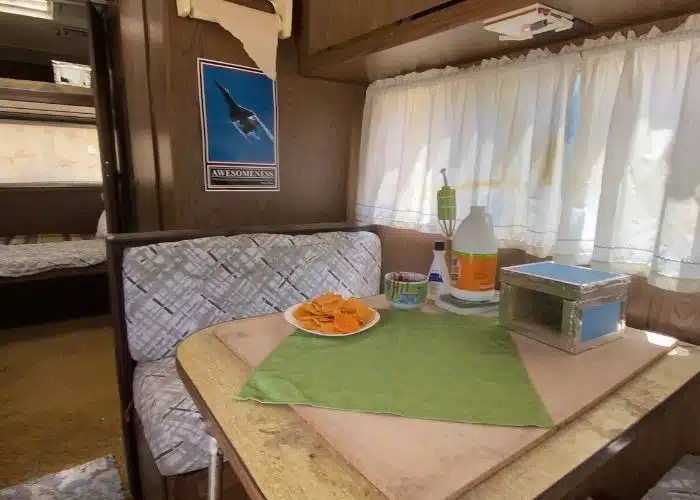
Everyday flammable items include corn chips, nail polish remover, candles etc
Trouble... RV Fire Cancelled?
Everything to this point was coming together really well. But then trouble struck. A forest fire started in the area, and there was some wind in the weather forecast, so a red flag (no burning) warning was issued. After months of planning and so many people who traveled great distances to be here, it looked like the RV fire would be canceled.
Even worse was that it seemed that fire season might have started early and that if we were not able to do the RV fire this week, we might need to wait until the snow started to fall in early winter. We were all understandably disappointed. But at least we could still go ahead and film some fire safety tips, fire extinguisher demonstrations, carbon monoxide testing, and other safety learning while we had all the firefighting professionals in the area. Then hope that the conditions would improve the next day. If not the next day, it was likely it would not happen for at least six months.
We learned a lot and will share even more with other blog posts and videos soon. Too much for a single article. Spoiler alert… as you probably saw in other pictures, we were able to do the RV fire the next day. The wind forecast completely dropped the following day, so everyone was on board to go ahead.

The motorhome is well and truly on fire, around 10 minutes in
The RV Fire Safety Burn
Fortunately, the weather cooperated, and the RV fire safety professionals were all comfortable with doing the RV fire demonstration. So, it was back ON!
We did our final preparations for the RV. Then the firefighters brought two fire engines to ensure we were extra safe. Then they simulated a cooking fire by lighting a fire on the stovetop.
Within 30 seconds, the smoke detectors went off, and smoke was filling the RV. In less than one minute, the RV was unfit for human life. Yes, an RV fire can become deadly in less than one minute.
The fire continued to build and quickly engulfed the entire inside of the RV. Flames began coming out of the roof, visible through the windows from outside. Within 5 minutes, the flames were over ten feet above the RV. Keep in mind that the average response time for a fire department is 8 minutes. And a more rural environment, like most RV parks and camping locations, would be much longer.
By 15 minutes, the RV was basically one giant fireball with a huge plume of black smoke filling the sky. There was a small explosion when the fuel nozzle for the gas tank shot out from the pressure of the heat. We had forgotten to remove the fuel cap! At that point, we asked the firefighters to extinguish, and they went to work putting out the blaze.
The Aftermath of the RV Fire
The crew of firefighters had the fire extinguished in about 3-4 minutes. Little remained of the RV. The frame and floor were intact, but most everything above that was charred remains.
Shockingly, our fireproof bag mostly survived the blaze, with our ‘important documents’ – including our book Living the RV Life – which were still mostly intact!
All three of our cameras inside the RV melted, despite the fire-resistant boxes we built to protect them. Fortunately, the SD cards from two of the melted cameras still saved the images we used in the main video.
If you haven’t watched the video yet, click here to watch it.
RV Fire Safety Tips
What Are The Most Common Causes of RV Fires?
There are of course many common causes of RV fires. Let’s run through some of the most common causes to help keep you safe!
Cooking in RVs
RV cooking fires are the most common source of RV fires when not in motion. Most RVs use propane stove tops, and all too often, there are flammable objects too close to the cooking area. Also, when cooking with grease or oils, it can burst into flames if the temperature gets too hot. Normally around 650 degrees F The small space and low ceilings in most RVs make it more dangerous than cooking in a traditional home.
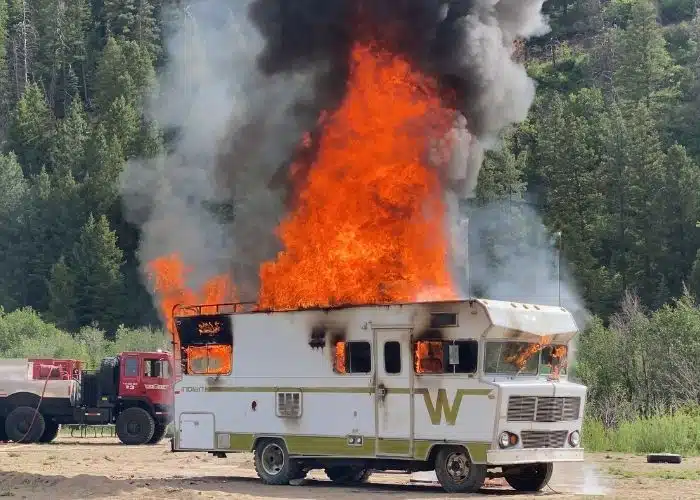
RV Fire Safety While In Motion
Trailer chains dragging and making sparks. You might have seen trailers that have safety chains that are too long, causing them to drag on the ground. This is especially noticeable at night. It only takes one stray spark to cause a fire.
Improperly inflated tires can overheat and cause a tire failure and/or a fire. Ensure your tires are at the proper temperature and pressure by installing and monitoring them with a Tire Pressure Monitoring System (TPMS). You can check out the review of our favorite system by clicking this link.
Improperly adjusted trailer brake settings sometimes cause overheating brakes, and sometimes from just driving too fast or with too much weight on steep grades. The brakes can catch on fire if overheated enough. But even if only a little overheated, they can still be a major hazard if you pull over onto the road shoulder or off-highway area where the wheels and brakes can come into contact with highly flammable material like dry grasses and weeds.
Similar to brakes, the wheel bearings on trailers can overheat if they are not properly greased. Once they overheat they can become a hazard similar to the hot brakes mentioned above.
Exhaust systems on your motorhome or towing vehicle can become very hot, especially the catalytic converter. If the exhaust comes in contact with flammable material like weeds or dry grasses, or fabrics, they can easily cause a fire.
Propane appliances in motion
Cooking or running propane appliances while in motion. Cooking while in motion is extremely dangerous, especially when cooking with propane. But other propane appliances like propane refrigerators can also be dangerous because they are only meant to be operated while level.
But when driving, your RV is often not level, especially when going up and down hills. If operated when not level, the flame can weaken the metals and cause the fridge to fail and cause a fire. Some newer propane fridges can be operated while in motion but still need to be turned off if not level for more than a couple of hours. Of course, dealing with a fire is dangerous enough when parked, but even more so when in motion.
Another reason to turn off propane appliances is that they can be especially dangerous in fuel stations. Some propane appliances like water heaters have an open flame. Gasoline vapor and an open flame are not a good combination.
Sign up for our email newsletter with the latest RV park reviews, news and updates.

An RV refrigerator fire totaled this Class A motorhome
RV Refrigerator Fires
Though many newer RVs are starting to use electric or residential-type refrigerators, historically, most RVs have fridges that operate on propane at least part of the time. These propane RV refrigerators or heat absorption fridges are great for conserving electricity when not hooked up to power, but they also have a few disadvantages.
Heat absorption RV refrigerators need to be level when in operation, If unlevel, the burner inside can heat unevenly and weaken the parts, which will eventually cause them to fail and cause a fire.
Because propane RV refrigerators need to be level while operating, Some newer models can be operated while in motion because of the changing angles and vibration. But, if stationary for more than a couple hours, it must be level to operate.
Another potential hazard with heat absorption RV refrigerators is that because of how much heat they produce, they need to be well-ventilated. The open vents required to operate them can attract insects, birds, and other pests to create nests in those areas. These nests near high temperatures can easily become a fire hazard, so you need to regularly check these areas to make sure they are free from debris and RV fire hazards.
RV Electrical Fires
RVs can be complex homes on wheels, especially some more modern ones that are filled with electronics. When wiring a traditional home, the wiring stays very stationary. But in an RV that is frequently in motion and bouncing. With the construction style and the movement, wires can sometimes experience abrasion that leads to damaging the electrical wires. And, the electrical systems in RVs are not always meant for some of today’s high-draw electrical appliances. So, RV electrical fires can be an increased risk.
These RV electrical fire hazards are, of course, in addition to electrical fire hazards you might be familiar with in your traditional home, like overloaded electrical outlets, extension cords connected to other extension cords, cords under rugs that don’t allow heat to dissipate, flammable materials near electric heating appliances.
Remember, if you have an electrically charged fire, never use water to put it out. Only use a fire extinguisher that is approved for type C fires.

The aftermath – the RV fire was extinguished by the fire crew after 15 mins of burning
RV Fire Hazards Also Found In Regular Homes
- Overloaded electrical outlets
- Loose fabrics near heat sources, especially synthetic fabrics.
- Rugs over cords don’t allow the heat to escape
- Daisy chained cords (plugging multiple extension cords together)
- Candles can cause a fire if tipped over, or if flammable material comes near the flame
- Smoking
- Cooking

The motorhome is fully engulfed in flames, this is at the 15 minute burning mark
Other Reasons RV Fires Can Be More Dangerous Than Traditional Home Fires
- Fewer and more difficult fire escape routes
- Unfamiliar environment for occasional travelers
- Less prepared/practiced using appliances, cooking in the space
- Wildland Urban interface (WUI). When in your RV, you often camp in the WUI, so you have the dangers of both environments. If another RVer or camper starts a fire in the area, you could be impacted by their fire.
- More flammable materials. Most home interior walls in North America are built with gypsum board (drywall) which is made up of 30% water. When there is a fire, the gypsum board can release some of this water, reducing flammability. RVs are mostly made of much more flammable material.
- Campfires nearby RVs, and in some cases, camping in areas that could be prone to wildfires.
How To Prevent RV Fires and Stay Safe
- Don’t overload electrical outlets
- Cook outside when possible
- Don’t cover cords with rugs or carpet
- Provide ventilation for any heat-generating electronics or appliances
- LED candles instead of regular candles
- Maintain and properly use heating sources
- Regular inspection for hazards in RV and surroundings
- Avoid campfires if any wind is present
- Be aware and mindful of fire restrictions in the area
- Don’t leave portable heaters running when sleeping
- Make sure your campfires are dead out and cool to the touch
- With clothing or loose fabrics like curtains, choose natural fabrics like cotton and hemp instead of synthetic fibers like polyester, which is much more flammable. If using synthetic fabrics, coat or dip them with fire-retardant coatings
- Regularly check wire connections for good connection
- If you smoke, do not throw your butts on the ground, and preferably only smoke outside
- Frequently check the undercarriage and outside panels of RV appliances to ensure that no pests have created nests and that there are no flammable materials present
- Practice emergency evacuation plans
- Never enter a vehicle or RV on fire
- Keep a spare set of keys handy for your towing vehicle for escape

RV Fire Safety Tools
- RV Smoke detector. Change the batteries every year, unless ten year battery, and replace the detector every ten years.
- Carbon monoxide detector. Consider a low-level detector with a digital display to alert you of low levels which can still cause harm over the long term. Change the batteries every year and replace the detector every ten years.
- RV Fire extinguishers in multiple places. We like to keep one in the bedroom, kitchen, entry area, outside storage, by the BBQ grill, or in the towing vehicle. Mount them in easy-to-see and reach locations for fast response.
- Types of fire extinguishers for RVs. For best safety, use those rated for both type A (wood, plastics, cloth, etc, AND type B (liquid fuel like grease, oil, stove, and motor fuel). It is good if they are also certified for type C fires (electrical) – Never use water on type B or type C fires!
- Water, shovel, and fire extinguishers for outdoor fires too. Keep it right by the fire.
- Surge protector (30A or 50A) for your RV electrical system.
- Consider switching appliances to an electric fridge and induction cooktop instead of a propane fridge and propane stove/cooktop.

Thank you to everyone who helped us pull of this crazy RV fire experiment!
Thank You!
Thank you to so many others who helped make this possible.
- Paul and Emily St. Ruth at Kebler Corner Cabins and Campground for offering their beautiful location for the RV Fire
- Chuck Altvater and Kyle from the Colorado Division of Fire Prevention and Control for sharing their wisdom, guidance, and support of resources
- Paonia Volunteer Fire Dept for keeping it all safe and putting the fire out
- Jason and Megan Rutel for helping to film the content
- Tim and Emily Rohrer from Own Less Do More, for volunteering to help with set up and clean up!
- RV Life for supporting this project and helping us share this important message with others
- To Mobile Must Have for sending us some fire extinguishers for our testing. More on those in a future post.
- The previous owners of Harvey the RV – Duane and Rose – for selling us their RV for a dollar for this cause
- To All of You for watching, and for sharing this blog post and video with others to help keep others safe!
Thank you again. We could not have done this without all of you!
GOT COMMENTS OR QUESTIONS?
We would love to hear from you. Drop us a note in the comments section below.
More Safety Related Content
Want to check out more safety related content? Hover over each image to see the post name.

RV Fire Safety: We Set an RV on Fire To Learn More

PepperBall LifeLite Self Defense Pepper Ball Gun

11 Tips for Traveling Safely in an RV During COVID-19

What Should RVers Do Now? How and Where to Shelter in Place During the Pandemic

RV Resource Roundup for COVID-19: FAQ + Links to Official Websites and Ongoing News Updates for RVers

13 Unexpected Benefits of Living and Traveling in an RV During the Coronavirus Pandemic

11 More RV Repairs, Mods and Upgrades To Our Motorhome

VIAIR 450P-RV Portable Automatic Air Compressor Review
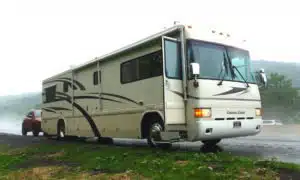
Something is Wrong! Our Death Wobble “Breakdown”

Tire Pressure Monitoring System (TPMS) TST 507

Where RVs Go To Die: RV Salvage Yard Lessons


18 thoughts on “RV Fire Safety: We Set an RV on Fire To Learn More”
Thank you for this excellent post. I have a comment about lithium batteries and one about fridges. 1) I heard a firefighter recently talk about how lithium batteries (he was discussing Teslas) terrify him. He said lithium batteries burn very hot, firefighters don’t yet have appropriate chemicals to handle the fires, and unlike traditional batteries, figuring out how to shut lithium car batteries down can be almost impossible. Since I have 400ah of lithium in my coach, I’ve started paying a lot more attention to fire safety and escape plans ever since that presentation. 2) In the UK, RV code requires that propane fridges automatically switch to DC when the coach is in motion, and also require that the fridge stay in DC for ten minutes after the coach is turned off, just in case the driver has stopped in order to fill the gas tank. Some North American manufacturers include as standard 3-way fridges with these automatic safety features, and I wish more would. (I can’t imagine such fridges are much more expensive than standard 3-ways.) I realize for trailers, traveling with your fridge in DC may deplete your batteries too far, but if you’re in a motorhome, your alternator should be able to keep up with the draw. The tricky part is remembering to switch it back to gas when you park. That’s where the auto-feature would be so helpful.
So glad you enjoyed the article and thank you for sharing! Yes, we too have heard of some scary stories with RV’s equipped with the Tesla batteries… it sounds cool and sexy… BUT so many people (including us) simply do not fully understand the chemistry and the risks. But we know enough not to go down that path with Tesla batteries! Excellent you are paying more attention to RV fire safety and escape plans. We really only have seconds or a minute tops to get out safely. Interesting about the UK RV code! I think we can learn a lot from them. Wishing you safe and happy travels! Thanks for commenting.
Very well done guys! So much good information that you shared. Thanks for all the work you put in to try to keep us all a little safer.
Glad you enjoyed it Cheryl 0 though we know that sounds like a weird thing to say about an RV fire video! Hopefully it will help educate a lot more people and help them stay safe in the future. Hope you and David are doing great!
OMG, you guys are absolutely the most bad a$$ RV pros. Thank you so much for making this video, and taking the time/skill/energy to educate all of us on the importance of fire safety!!!! Huge love from the HoneyTrek team!
You are welcome. Always great to hear from you and hugs right back at you!
Great Job to everyone involved in this project.
Thank you – glad you enjoyed it and hope you learned a few things!
“Because propane RV refrigerators need to be level while operating, it is discouraged to operate them while in motion. When in motion, your RV is frequently unlevel, especially when traveling on hilly roads.”
I don’t believe this is true as yes the RV is frequently not level but being in motion the shaking compensates for the absorption frig to work safely.
Also, you state repeatedly about the frigs needing to be “level”, but to be accurate they need to be level within spec which is in the range of 20 degrees of true level, to be operating safely.
Hi Mike, It is true that some of the newer propane fridges are more tolerant of off level, especially while in motion, but there are still many older fridges out there that are less forgiving. And I just think that in general it is a good practice so that people don’t forget to turn them off when entering fuel stations (which owners manuals on newer units still strongly advise against), and also to avoid stopping somewhere, parked un level, for a couple hours. Not sure about your info on the 20 degrees from true level. The owners manuals I have read still state that it must be level while in operation for more than a few hours. No reference to range of off level that is acceptable. But thank you for sharing your thoughts.
Thank you for this article and photos. This is a very important subject. I’ve been RVing since 1979 and I’ve often left the propane on in the fridge except at fuel stations. This next trip this month, no propane will be on. Also I need another fire extinguisher too. I learned some things from this presentation and it was also a reminder of things I may have gotten lax about.
Thanks for sharing Joyce… yes it’s easy for all of us to get lax, but it can all happen so quickly! We have several of these fire fight foam cans around our RV (inside and out) in our tow vehicle, and in our home too, one by the BBQ. https://www.mobilemusthave.com/Fire-Safety_c_55.html?Affid=4
We always have one with arm’s reach at any place where a fire could occur. We even had one above our bed in the motorhome rear bedroom….in case a fire started at night. These work really well as they are easy to use and not corrosive like the chemicals in the fire extinguishers so wont’ damage electronics, if used. Luckily we haven’t had to use them in a real fire situation – only burn demonstrations – but they give us a lot of peace of mind to have around! Hope this helps and safe travels! Good idea to turn that propane off when in transit. You mentioned the article and photos – hope you got a chance to watch the video too!
Gypsum board is far less than 30% water! 30% water content = mud. This link has several comments gypsum moisture. Gypsum is fire resistant because the gypsum is basically dirt and does not burn. The only combustible part is the paper backing on each side. Very good demonstration through.
https://www.google.com/search?q=gypsum+board+moisture+content&oq=gypsum+board+moisture+content&aqs=chrome..69i57.7134j0j7&sourceid=chrome&ie=UTF-8
Thanks for sharing! We weren’t about to question the fire expert… but glad you enjoyed the video!
You two are simply crazy…. and I love it. You did something similar as couple of years ago and I bought your “Living the RV Life” book as a way of saying thanks for all the great stuff you two discuss. So with this “Burning Down The (RV) House” video I just had to buy your new book, RV Hacks. Keep up the good works.
Thanks Again.
Kim & Karen Wardle
Those are hilarious reasons for buying our books! LOL Being crazy!? What was the other crazy thing we did a couple of years ago? Renovate an old RV in under a month? That was crazy LOL. We do like to do things “different” for sure. Enjoy the books! And hope you learned some useful tips in the RV fire video / post!
Extremely powerful video. Well written article with great tips. I will follow your advice.
Glad you found it useful Scott!